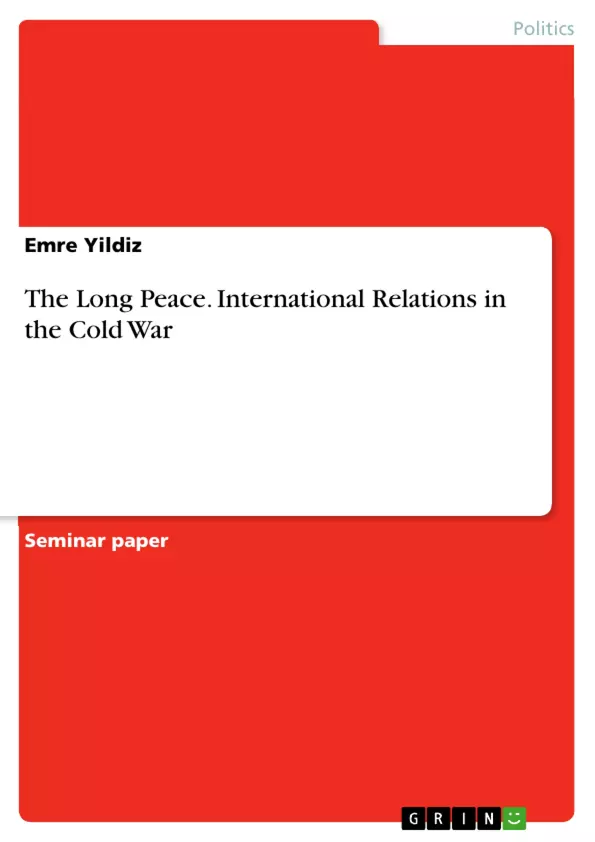The year 2012 marks the 67th year since which time the world has not seen any direct military confrontation between superpowers. When World War II ended in 1945 the “Cold War” came about and was fought out by the USA and Soviet Union with mediate means. Even the end of the US-Soviet conflict preceded peacefully – a historical unusual demise for a struggling super power. Furthermore, there has been no war among the USA and the aspirants of super power including China, Japan, Russia and the European Union ever since. This discovery is named the long peace, also known as the great powers peace.
However, it is hard to say whether a sixty four year long absence of direct military confrontations between great powers is already a significant indicator for a qualitative shift in international politics, or whether it is nothing but a historical and contemporary randomness. Could the long peace cease anytime resulting in an apocalyptic world war, or are we indeed justified to conclude a positive change in the relations among great powers compared with earlier times? More importantly even, are we right in calling this period a long peace, and if so, up to what degree?
In this paper I want to undertake three things in turn. First I want to show due to what particularities inherent in the long peace we may conclude a significant change in great powers’ relations. Next I will seek to grade the long peace in its nature and stability. And lastly, I shall turn to two theories in order to illustrate how the emergence of the long peace and its enduring appearance down to the present day has been made possible.
I chose this topic for two reasons: Firstly, peace-studies are one of the greatest focuses in the discipline of International Politics. Finding appropriate ways and means to maintain peace in the world has been the original inducement of erstwhile historians, jurists and political scientists to arouse a new branch of science nearly a century ago. The second and more important reason is that the phenomena long peace reveals a noteworthy gap in International Politics. Neither of both theories, as will be seen, is capable of fully illuminating the long peace on its own.
Table of Contents
- Introduction
- The Long Peace
- Features of the Long Peace
- Definitions
- Definition of Power
- Definition of Great Power
- Offensive and Defensive Great Powers
- Hegemony
- Definition of Peace
- Definition of Stable Peace
- Definition and Types of War
- Bipolarity and Nuclear Technology – The Realist Perspective
- Bipolarity
- Technology
- Gaps in Explanation
- Dysfunctionality and Regimes - The Institutionalist Perspective
- Dysfunctionality of War
- International Regimes
- Gap in Explanation
- Conclusion
Objectives and Key Themes
This paper examines the concept of the "long peace," a period of relative stability between great powers since World War II. The paper aims to demonstrate the significance of this period by exploring its unique characteristics and analyzing its potential for long-term peace. It then analyzes the realist and institutionalist perspectives on the long peace, highlighting both their contributions and their limitations in explaining this phenomenon. The key themes discussed include:- The nature and significance of the long peace
- The changing dynamics of great power relations
- The role of technology and international regimes in maintaining peace
- The limitations of realist and institutionalist perspectives in fully explaining the long peace
Chapter Summaries
The paper begins with an introduction that sets the context for the discussion of the long peace. It establishes the historical context, defining the period as the absence of direct military conflict between great powers since 1945. The introduction highlights the long peace as a significant phenomenon, considering the traditional cycle of power struggles and hegemony. The second chapter explores the key features of the long peace. It examines three notable shifts: the peaceful ending of the US-Soviet conflict, the decrease in superpower crises, and the reduction in proxy wars. These shifts highlight the unique nature of the current period compared to previous eras marked by greater inter-state conflict. Chapter three delves into the definitions of central concepts, including "power," "great power," "peace," "stable peace," and "war." This section clarifies the terminology used throughout the paper, providing a framework for understanding the long peace within the context of international relations theory. The fourth chapter examines the realist perspective on the long peace. This section discusses the influence of bipolarity and nuclear technology in deterring direct military conflict between superpowers. It acknowledges the realist explanation's limitations in fully accounting for the long peace's emergence and persistence. Chapter five focuses on the institutionalist perspective. It explores the role of international regimes in maintaining stability and reducing the likelihood of war. This section analyzes the contribution of international institutions in promoting cooperation and mitigating conflict. The final section summarizes the key arguments and presents potential directions for further research. This section highlights the need for a more comprehensive approach to understanding the long peace, considering the limitations of both realist and institutionalist perspectives.
Keywords
The paper centers around the concepts of great power relations, long peace, international politics, realism, institutionalism, bipolarity, nuclear technology, international regimes, and the dynamics of conflict and cooperation. It explores the emergence and persistence of peace between major powers in the post-World War II era, analyzing the interplay of structural factors, technological advancements, and institutional arrangements.- Quote paper
- Emre Yildiz (Author), 2012, The Long Peace. International Relations in the Cold War, Munich, GRIN Verlag, https://www.grin.com/document/232022



